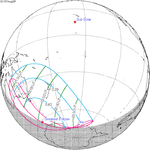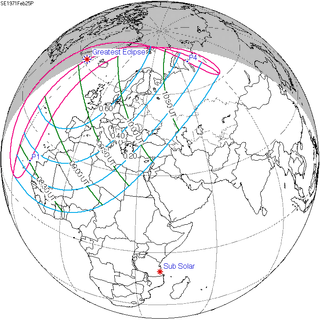Solar eclipse of February 25, 1971
Appearance
| Solar eclipse of February 25, 1971 | |
|---|---|
| Type of eclipse | |
| Nature | Partial |
| Gamma | 1.1188 |
| Magnitude | 0.7872 |
| Maximum eclipse | |
| Coordinates | 61°24′N 33°30′W / 61.4°N 33.5°W |
| Times (UTC) | |
| Greatest eclipse | 9:38:07 |
| References | |
| Saros | 149 (18 of 71) |
| Catalog # (SE5000) | 9444 |
A partial solar eclipse occurred on February 25, 1971. A solar eclipse occurs when the Moon passes between Earth and the Sun, thereby totally or partly obscuring the image of the Sun for a viewer on Earth. A partial solar eclipse occurs in the polar regions of the Earth when the center of the Moon's shadow misses the Earth.
Related eclipses
Solar eclipses of 1968-1971
This eclipse is a member of a semester series. An eclipse in a semester series of solar eclipses repeats approximately every 177 days and 4 hours (a semester) at alternating nodes of the Moon's orbit.[1]
The partial solar eclipse on July 22, 1971 occurs in the next lunar year eclipse set.
| Solar eclipse series sets from 1968 to 1971 | ||||||
|---|---|---|---|---|---|---|
| Ascending node | Descending node | |||||
| Saros | Map | Gamma | Saros | Map | Gamma | |
| 119 | March 28, 2968 Partial |
−1.037 | 124 | September 22, 1968 Total |
0.9451 | |
| 129 | March 18, 1969 Annular |
−0.2704 | 134 | September 11, 1969 Annular |
0.2201 | |
139 Totality in Williamston, NC USA |
March 7, 1970 Total |
0.4473 | 144 | August 31, 1970 Annular |
−0.5364 | |
| 149 | February 25, 1971 Partial |
1.1188 | 154 | August 20, 1971 Partial |
−1.2659 | |
References
- ^ van Gent, R.H. "Solar- and Lunar-Eclipse Predictions from Antiquity to the Present". A Catalogue of Eclipse Cycles. Utrecht University. Retrieved 6 October 2018.
External links
- Earth visibility chart and eclipse statistics Eclipse Predictions by Fred Espenak, NASA/GSFC
Wikimedia Commons has media related to Solar eclipse of 1971 February 25.




